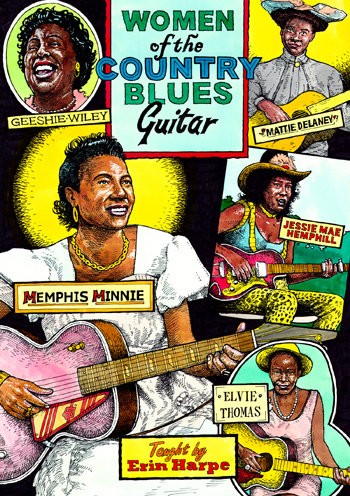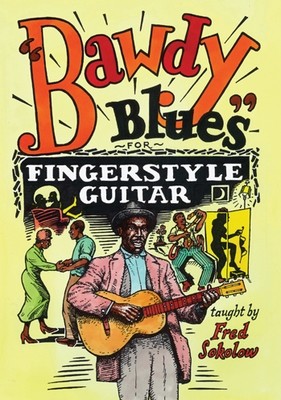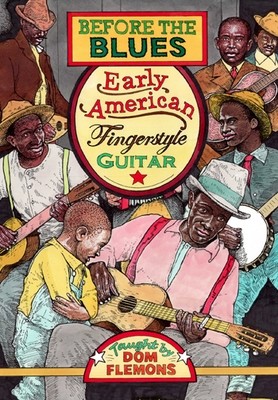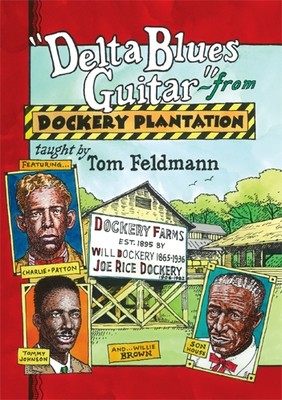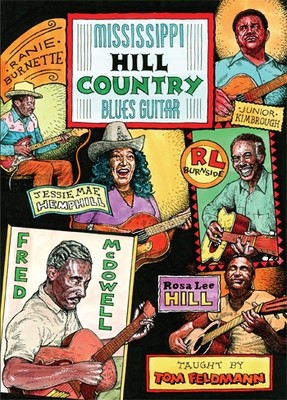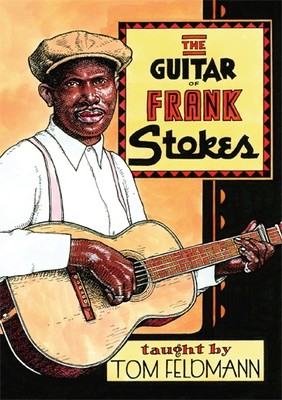
Women of the Country Blues Guitar - taught by Erin Harpe
Although the fingerstyle delta blues of the 1920's and 1930's was mostly male-dominated, there were a number of women who emerged in the style early on. The best known and influential was Memphis Minnie, who recorded over 200 songs from 1929 to 1959. Her performances and songwriting made her well known in a genre associated with men. In this lesson Erin Harpe takes you through some of Memphis Minnie's early material in Open G (Spanish tuning) i.e. Can I Do It For You, Where Is My Good Man At, What's The Matter With The Mill, When The Levee Breaks, as well as a few in Standard tuning.
Erin also gives an overview of other early-accomplished guitar-playing blues women including Geeshie Wiley, Elvie Thomas, and Jesse Mae Hemphill. In March 1930, Geeshie Wiley and L.V. Thomas (named as Elvie by the record company) traveled from Houston, Texas to Grafton, Wisconsin, to make recordings for Paramount Records. They recorded together a handful of country blues masterpieces. Erin teaches both Motherless Chile and Pick Poor Robin Clean.
Mattie Delaney is thought to have come from Tchula, Mississippi. She recorded only two songs in 1930 for Vocalion Records. Very little is known about her but her playing and singing was masterful. Erin teaches Mattie's Down The Big Road Blues played in Open G (Spanish) tuning.
The last woman blues player featured is Jessie Mae Hemphill. She was born in Como, Mississippi in 1923 and began playing guitar at the age of seven. Her first recordings were field recordings made by the blues researcher George Mitchell in 1967. Her I'm So Glad is a fine example of Mississippi Hill Country blues.
Each tune is taught phrase by phrase and played slowly on a split-screen. Bonus audio tracks of the original recordings are included.
Titles include: MEMPHIS MINNIE I'm a Bad Luck Woman, Nothing In Rambling, Can I Do It For You, Where Is My Good Man At, What's The Matter With The Mill, When The Levee Breaks MATTIE DELANEY Down The Big Road Blues ELVIE THOMAS Motherless Chile GEESHIE WILEY Pick Poor Robin Clean JESSIE MAE HEMPHILL I'm So Glad
124 minutes - Level 2/3 - Detailed tab/music PDF file on the DVD
Review: For two hours, Erin Harpe instructively reminds us - note for note on her trusty acoustic - that Robert Johnson, Blind Lemon Jefferson and Blind Blake were not the only first-generation guitar heroes. Her Women of the Country Blues Guitar lesson builds its 10 song repertoire from one of the rarest blues commodities: prewar ladies who accompanied themselves by snapping and bending strings just as thrillingly as did their male counterparts. Justifiably, the prolific Memphis Minnie grabs the lion's share of material, chugging "What's the Matter with the Mill" and stomping"I'm a Bad Luck Woman" with brutish bass lines. "When the Levee Breaks" is the epitome of classic. Here, Minnie is up against virtual phantoms like Texan Elvie Thomas (in lullaby form, "Motherless Chile" renders misery beautiful) or the Delta's Mattie Delaney (chordlessly fingerpicked, "Down the Big Road Blues" is anything but a Tommy Johnson carbon copy), whose meager but mighty handful of shellac is just about their only existing trace. Geeshie Wiley is arguably the more known of these unknowns, thanks to a memorable name and even more unforgettable songs. Her high-compression "Pick Poor Robin Clean" moves briskly and brightly. But Harpe's inspirations don't all spin at 78 rpm. For when R.L. Burnside and Junior Kimbrough were spinning their rhythmic spells up in north Mississippi , Jessie Mae Hemphill was casting her own hill-country trance by welding a D chord onto a roughhouse riff to contradictorily express "I'm So Glad." Her 1986 version, which resides here along with all the other bonus original recordings, is juke joint-worthy. – Dennis Rozanski/Blues Rag
Review: There have been some great women guitarists in Country Blues, especially Memphis Minnie. So it's appropriate that a woman should be teaching these guitar parts too. Although Erin seems a little nervous in front of the camera just at the beginning, once she is into the lessons that disappears and she's fine. Several songs by Minnie are taught, and also one each by Elvie Thomas, Geeshie Wiley, Jessie Mae Hemphill and Mattie Delaney. There are songs in standard tuning, one in open D and several in open G. The style of the lessons is the same as in many other titles we've reviewed here: first the song is played, with two cameras on the teacher so you get a good look at both hands. Then she explains each part of the song showing how the licks are played, followed by a split screen look at both hands as she plays the part again slowly. About the middle Erin explains that she came by all this naturally, because her dad was also a Country Blues guitarist who gave her the first lessons on the instrument! I found that interesting, and enjoyed her playing here. One can of course use licks taught in these DVDs for your own songs, or add the ones taught to your repertoire, or both. You can even use the DVD as a concert by fon/varding past the lessons to just see Erin playing the songs. There is also tablature in a PDF file included on the disc, as well as the original recordings of the songs being taught - that's a lot of bonuses! It's over two hours of lesson. – Blue Suede New
Review: There are dozens of titles available at Stefan Grossman's Guitar Workshop, and there is a diverse collection of artists that provide the instruction. One of these fine instructors is Erin Harpe, talented guitarist and vocalist with serious on-stage experience. Her contribution to the catalog is a two-hour lesson, Women of the Country Blues Guitar. This is a not only a cool opportunity to learn some classic tunes, but it is also an important history lesson for the learner. The subjects of this lesson include artists that you probably have heard of, such as Memphis Minnie, but there may be a few surprises for you too.
Memphis Minnie is one of the best known women of blues guitar, having recorded over 200 songs between 1929 and 1959. Erin Harpe guides the student through seven of Minnie's tunes, and after playing through a song (and singing it too!), Erin provides a little history and a description of how to play the song along with split screen examples. Where necessary, Harpe goes through solos in more detail too. Each of these is broken up neatly into chapters so the learner can jump back and forth to the parts they need more help with. Memphis Minnie songs in this lesson include, "I'm a Bad Luck Woman," "Nothing in Rambling," "Can I do it for You," " Where is My Good Man At," "What's the Matter with the Mill," and "When the Levee Breaks."
A similar learning strategy is used with the other four songs, each of which was originally performed by artists with fascinating backstories. Geeshie Wiley and L.V. "Elvie" Thomas made their way from Houston, Texas to Grafton, Wisconsin, to record country blues for Paramount Records, and you will find "Pick Poor Robin Clean" and "Motherless Chile" included in the lessons. There is also "I'm So Glad" from Mississippi's Jessie Mae Hemphill. Jessie started playing guitar in 1930, but never was in the limelight, and did not start releasing albums until the 1980s. Lastly, there is the mystery of Mattie Delaney from Mississippi, who recorded only two songs in 1930 for Vocalion Records. There is nothing written about her after this, and it is beyond cool that her version of "Down The Big Road Blues" has not been forgotten.
As some of these songs were originally recorded in open G tuning (also know as Spanish tuning), Erin demonstrates tuning the guitar in this manner as well as some common chords that are used with this tuning. This is a handy reference and it is nice that Harpe guides the learner through this before teaching the songs that use this tuning.
There are a few bonus features on the Women of the Country Blues Guitar DVD. For starters, there is a .pdf booklet on the disc that includes tablature and lyrics for each song. This document does not come up on the DVD menu, but you can find it with Internet Explorer (PC) or Finder (Mac). Also, there are audio tracks by the original artists for each of the ten songs in the lesson; this provides a nice comparison to see how close the student is to achieving competency with the source material.
This DVD is a professional project with good lighting, clean editing, plenty of camera angles, and crystal clear sound. The guitar cuts through nicely, both through headphones and laptop speakers, but it would be nice to play it through a quality pair of speakers if you have the opportunity. It is helpful that the learner can move along at their own pace, though these lessons would probably be most appropriate for intermediate and higher level students. There are plenty of other blues DVDs available from guitarvideos.com that would be more appropriate for beginners.
If you are looking for a good value in guitar instruction it would be a fine idea to head on over to Stefan Grossman's Guitar Workshop website and see what they have to offer for you. For less than the price of one in-person lesson you can pick up a DVD or two that will get you a good head start towards your guitar playing goals.
Stefan Grossman is a music publisher AND a serious guitar slinger. He hails from Brooklyn, and was taught by the esteemed Reverend Gary Davis as well as other legends that include Son House, Skip James, and Mississippi John Hurt. After endless touring, in the late 1960s he started to produce instructional albums with play-along tablature, including his famous 1967 LP, How to Play Blues Guitar. As time went on the catalog grew and these titles became available on CDs, VHS tapes, and DVDs; now there are downloadable lessons too!
Women of the Country Blues Guitar from Stefan Grossman's Guitar Workshop has a lot going for it, as Erin Harpe is an outstanding teacher, and this is a well-made DVD with compelling subject matter. Better yet, it is also a great value, as the learner only has to pay $29.95 for a two-hour lesson. Even if you are not a guitar player, it is fascinating to see how the songs are constructed, as well as the effort that goes into learning and playing these tunes! – Rex Bartholomew/Blues Blast Magazine
